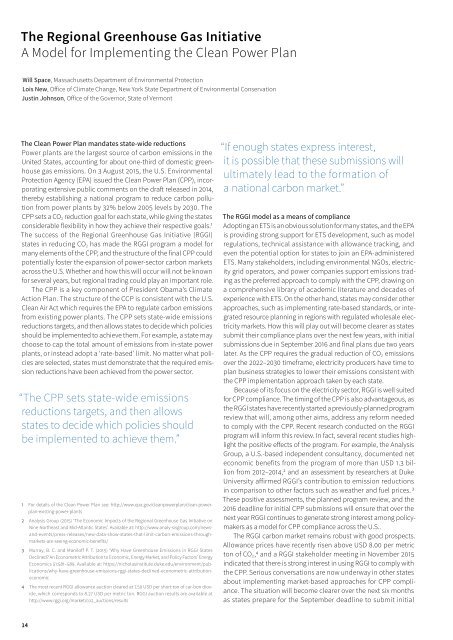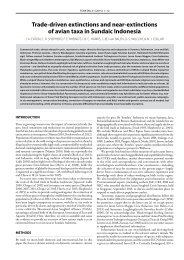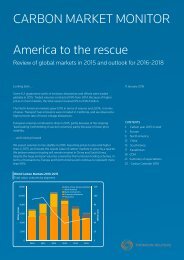Emissions Trading Worldwide
1TbjEHd
1TbjEHd
You also want an ePaper? Increase the reach of your titles
YUMPU automatically turns print PDFs into web optimized ePapers that Google loves.
The Regional Greenhouse Gas Initiative<br />
A Model for Implementing the Clean Power Plan<br />
Will Space, Massachusetts Department of Environmental Protection<br />
Lois New, Office of Climate Change, New York State Department of Environmental Conservation<br />
Justin Johnson, Office of the Governor, State of Vermont<br />
The Clean Power Plan mandates state-wide reductions<br />
Power plants are the largest source of carbon emissions in the<br />
United States, accounting for about one-third of domestic greenhouse<br />
gas emissions. On 3 August 2015, the U.S. Environmental<br />
Protection Agency (EPA) issued the Clean Power Plan (CPP), incorporating<br />
extensive public comments on the draft released in 2014,<br />
thereby establishing a national program to reduce carbon pollution<br />
from power plants by 32% below 2005 levels by 2030. The<br />
CPP sets a CO 2 reduction goal for each state, while giving the states<br />
considerable flexibility in how they achieve their respective goals. 1<br />
The success of the Regional Greenhouse Gas Initiative (RGGI)<br />
states in reducing CO 2 has made the RGGI program a model for<br />
many elements of the CPP, and the structure of the final CPP could<br />
potentially foster the expansion of power-sector carbon markets<br />
across the U.S. Whether and how this will occur will not be known<br />
for several years, but regional trading could play an important role.<br />
The CPP is a key component of President Obama’s Climate<br />
Action Plan. The structure of the CCP is consistent with the U.S.<br />
Clean Air Act which requires the EPA to regulate carbon emissions<br />
from existing power plants. The CPP sets state-wide emissions<br />
reductions targets, and then allows states to decide which policies<br />
should be implemented to achieve them. For example, a state may<br />
choose to cap the total amount of emissions from in-state power<br />
plants, or instead adopt a ‘rate-based’ limit. No matter what policies<br />
are selected, states must demonstrate that the required emission<br />
reductions have been achieved from the power sector.<br />
“The CPP sets state-wide emissions<br />
re ductions targets, and then allows<br />
states to decide which policies should<br />
be implemented to achieve them.”<br />
1 For details of the Clean Power Plan see: http://www.epa.gov/cleanpowerplan/clean-powerplan-existing-power-plants<br />
2 Analysis Group (2015) ‘The Economic Impacts of the Regional Greenhouse Gas Initiative on<br />
Nine Northeast and Mid-Atlantic States’. Available at: http://www.analy-sisgroup.com/newsand-events/press-releases/new-data-show-states-that-limit-carbon-emissions-throughmarkets-are-seeing-economic-benefits/<br />
3 Murray, B. C. and Maniloff P. T. (2015) ‘Why Have Greenhouse <strong>Emissions</strong> in RGGI States<br />
Declined? An Econometric Attribution to Economic, Energy Market, and Policy Factors’ Energy<br />
Economics 51:581–589. Available at: https://nicholasinstitute.duke.edu/environment/publications/why-have-greenhouse-emissions-rggi-states-declined-econometric-attributioneconomic<br />
4 The most recent RGGI allowance auction cleared at 7.50 USD per short ton of car-bon dioxide,<br />
which corresponds to 8.27 USD per metric ton. RGGI auction results are available at<br />
http://www.rggi.org/market/co2_auctions/results<br />
“If enough states express interest,<br />
it is possible that these submissions will<br />
ultimately lead to the formation of<br />
a national carbon market.”<br />
The RGGI model as a means of compliance<br />
Adopting an ETS is an obvious solution for many states, and the EPA<br />
is providing strong support for ETS development, such as model<br />
regulations, technical assistance with allowance tracking, and<br />
even the potential option for states to join an EPA-administered<br />
ETS. Many stakeholders, including environmental NGOs, electricity<br />
grid operators, and power companies support emissions trading<br />
as the preferred approach to comply with the CPP, drawing on<br />
a comprehensive library of academic literature and decades of<br />
experience with ETS. On the other hand, states may consider other<br />
approaches, such as implementing rate-based standards, or integrated<br />
resource planning in regions with regulated wholesale electricity<br />
markets. How this will play out will become clearer as states<br />
submit their compliance plans over the next few years, with initial<br />
submissions due in September 2016 and final plans due two years<br />
later. As the CPP requires the gradual reduction of CO 2 emissions<br />
over the 2022–2030 timeframe, electricity producers have time to<br />
plan business strategies to lower their emissions consistent with<br />
the CPP implementation approach taken by each state.<br />
Because of its focus on the electricity sector, RGGI is well suited<br />
for CPP compliance. The timing of the CPP is also advantageous, as<br />
the RGGI states have recently started a previously-planned program<br />
review that will, among other aims, address any reform needed<br />
to comply with the CPP. Recent research conducted on the RGGI<br />
program will inform this review. In fact, several recent studies highlight<br />
the positive effects of the program. For example, the Analysis<br />
Group, a U.S.-based independent consultancy, documented net<br />
economic benefits from the program of more than USD 1.3 billion<br />
from 2012–2014, 2 and an assessment by researchers at Duke<br />
University affirmed RGGI’s contribution to emission reductions<br />
in comparison to other factors such as weather and fuel prices. 3<br />
These positive assessments, the planned program review, and the<br />
2016 deadline for initial CPP submissions will ensure that over the<br />
next year RGGI continues to generate strong interest among policymakers<br />
as a model for CPP compliance across the U.S..<br />
The RGGI carbon market remains robust with good prospects.<br />
Allowance prices have recently risen above USD 8.00 per metric<br />
ton of CO 2 , 4 and a RGGI stakeholder meeting in November 2015<br />
indicated that there is strong interest in using RGGI to comply with<br />
the CPP. Serious conversations are now underway in other states<br />
about implementing market-based approaches for CPP compliance.<br />
The situation will become clearer over the next six months<br />
as states prepare for the September deadline to submit initial<br />
14




